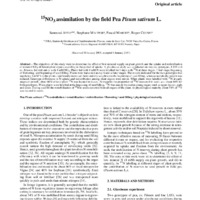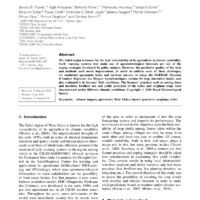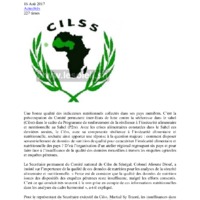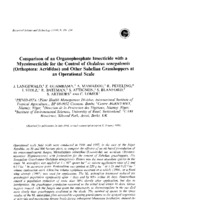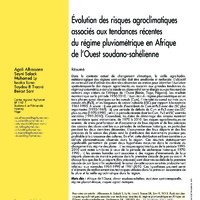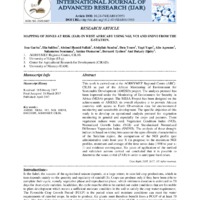Recherche
6 items
15NO3 assimilation by the field Pea Pisum sativum L.
Abstract – The objectives of this study were to determine the effect of low mineral supply on plant growth and the uptake and redistribution of mineral N by different plant organs according to the period of uptake. A glasshouse study was conducted on two pea genotypes, L833 and cv. Frisson, fed without or with 4 mM NO3. Plants fed with 4 mM N were labelled for 5 days with 15N at three stages: 7 leaf stage, beginning of flowering, and beginning of seed filling. Plants were harvested at day 6 and at later stages. The results indicated for the two genotypes that supplying 4 mM N to the plants significantly increased their total dry weight up to the beginning of seed filling, whereas nodule dry weight was reduced. Genotype differences in N uptake and redistribution among plant organs were minor. When plants were labelled with 15N at early stages of growth, about 60& of total plant 15N was located in leaves. At maturity the proportion of 15N recovered in seeds was about 60& for both genotypes. When plants were labelled at the beginning of seed filling, 15N was mainly located in young organs such as upper leaves, pods and seeds. During seed fill the remobilisation of 15N to seeds occurred from all organs of the plant. At physiological maturity about 70& of 15N was located in seeds.
Characterizing and modeling the diversity of cropping situations under climatic constraints in west africa
The Sahel region is known for the high vulnerability of its agriculture to climate variability. Early warning systems that make use of agrometerological forecasts are one of the coping strategies developed by policy makers. However, the predictive quality of the tools and methods used needs improvement. In order to address some of these challenges, we conducted agronomic trials and on-farm surveys to adapt the SARRAH (Syst`eme d’Analyse R´egionale des Risques Agroclimatiques, version H) crop simulation model, and also evaluated it in farmers’ field conditions. The farmers’ practices such as sowing dates and densities, fertilizer use and yields potentials of the millet and sorghum crops were characterized under different climatic conditions.
Evolution des risques agroclimatiques associés aux tendances récentes du régime pluviométrique en afrique de l’ouest soudano-sahélienne
Dans le contexte actuel de changement climatique, la veille agro-hydrométéorologique des regions semi-arides doit être ameliorée et renforcée. L’objectif de ce travail est d’utiliser des données observées en station pour identifier l’evolution spatio-temporelle des risques agroclimatiques associés aux grandes tendances du régime pluviométrique dans la bande soudano-sahélienne élargie aux parties Nord de certains pays côtiers de l’Afrique de l’Ouest (Benin, Togo, Nigeria). Les resultats montrent que sur la periode 1950-2010, l’evolution du regime pluviometrique est en trois phases quasi identiques sur les cumuls (Cum), l’intensite du cumul sur trois jours consecutifs (Px3), et les longueurs de saison culturale (LSC) par rapport a la normale 1961-1990. A savoir : i) une periode d’excedents de Cum et Px3 avec des LSC plus importantes (1950-1969) ; ii) une periode de deficits de Cum et Px3 avec des LSC plus courtes (1970-1990) ; et iii) la période récente dont les Cum, Px3 et LSC sont trés variables (1991-2010). Cependant, les dates de demarrage des saisons montrent une tendance quasi stationnaire, de 1970 a 2010. Les risques agroclimatiques de resemis, de stress post-floraison et d’occurrence de faux departs et de fins precoces des saisons des pluies sont lies aux periodes de secheresse historique, en particulier pendant les deux dernieres decennies. L’occurrence des faux departs et des fins precoces de la saison des pluies rend la distribution des evenements pluvieux peu profitable à la croissance des cultures
Mapping of zones at risk in west Africa by using NGI, VCI and SNDVI from the E-Station.
This work is carried out at the AGRHYMET Regional Centre (ARC)-CILSS as part of the African Monitoring of Environment for Sustainable Development (AMESD) project. The analysis protocol has been improved under the Monitoring of Environment for Security in Africa (MESA) project. The MESA Project has been designed on the achievements of AMESD; its overall objective is to provide African countries with access to Earth Observation data for environmental monitoring and sustainable development. The specific objective of this study is to develop an operational analysis protocol for vegetation monitoring in general and especially for crops and pastures. Three vegetation indices were used: Vegetation Condition Index (VCI), Normalized Growth Index (NGI) and Standardized Normalized Difference Vegetation Index (SNDVI). The analysis of these drought indices is based on taking into account the agro-climatic characteristics of the Sahelian region, the comparison of the NGI profile (per administrative unit) from year X (in progress) to the maximum NGI profiles, minimum and average of the time series data (1998 to year x-1) and evidence convergence. Six years of application of the method and validation actions carried out concluded that it is possible to determine the zones at risk (ZAR) in order to anticipate food crises.
